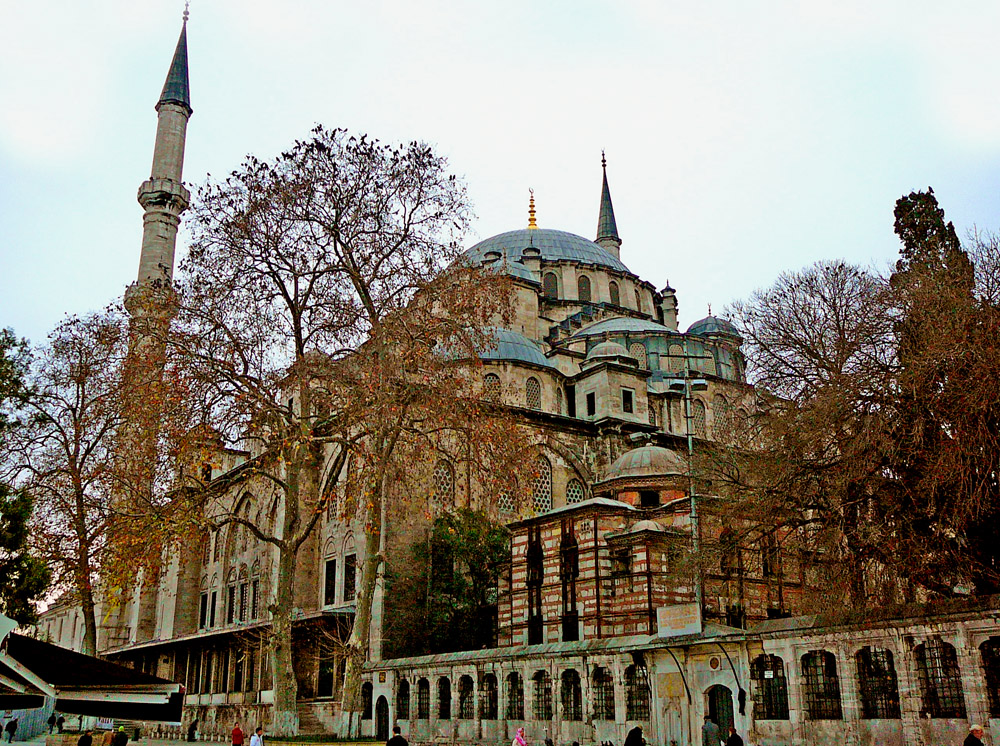- Fatih Mosque (Istanbul)
Infobox religious building
building_name = Fatih Mosque
infobox_width = 300px

image_size = 300px
caption = Fatih Mosque
map_type =
map_size =
map_caption =
location =Istanbul ,Turkey
geo = coord|41|1|11|N|28|56|59|E|region:TR-34_type:landmark
religious_affiliation =Islam
rite =
region =
state =
province =
territory =
prefecture =
sector =
district =
cercle =
municipality =
consecration_year =
status =
functional_status =
heritage_designation =
leadership =
website =
architecture = yes
architect =Atik Sinan , Mimar Mehmet Tahir
architecture_type = mosque
architecture_style =
general_contractor =
facade_direction =
groundbreaking = 1463
year_completed = 1771
construction_cost =
specifications = yes
capacity =
length =
width =
width_nave =
height_max =
dome_quantity =
dome_height_outer =
dome_height_inner =
dome_dia_outer =
dome_dia_inner = M to ft|26
minaret_quantity = 2
minaret_height =
spire_quantity =
spire_height =
materials =granite ,marble The Fatih Mosque ( _tr. " Fatih Camii") or "Conqueror's Mosque" in English) is an Ottoman imperial
mosque located in theFatih district ofIstanbul ,Turkey . It was the largest example of Turkish-Islamic architecture in Istanbul and represented an important stage in the development of classicTurkish architecture .History
The Fatih Mosque was constructed by order of
Fatih Sultan Mehmed the Conqueror from 1463-1470, on the site of the former ByzantineChurch of the Holy Apostles , whose ruins served as a quarry to supply building materials for the new mosque. The architect wasAtik Sinan , about whom little is known.The original complex included a set of well-planned buildings constructed around the mosque. They include eight
medrese , library, hospital, hospice,caravanserai , market,hamam , primary school and public kitchen ("imaret ") which served food to the poor. Variousturbe were added at a later dates. The original complex covered an almost square area 325 meters on a side, extending along theGolden Horn side of Fevzipasa Street..The original mosque was badly damaged in the 1509
earthquake , after that it was repaired, but was then damaged again by earthquakes in 1557 and 1754 and repaired yet again. It was then completely destroyed by an earthquake on22 May 1766 when the main dome was collapsed and the walls were irreparably damaged. The current mosque (designed on a completely different plan) was completed in 1771 under SultanMustafa II by the architect,Mimar Mehmet Tahir .Architecture
Exterior
There has been considerable speculation about the original design of Faitih Mosque, which contemporary accounts compared with the
Hagia Sophia . The courtyard, main entrance portal and lower portions of the minarets remain from the original construction, with the remainder consisting of the 1771Baroque reconstruction.Interior
The present interior of the Fatih Mosque is essentially a copy of earlier designs invented by
Sinan re-used repeatedly by himself and his successors throughout Istanbul. The 26 meter diameter center dome is supported by four semi-domes on each axis supported by four large marble columns. There are twominaret s each with twin galleries. Thecalligraphy within the mosque and themimbar exhibit aBaroque influence, but the white tiles of inferior quality are a poor comparison with the İznik tiled splendor of mosques such as theRüstem Pasha Mosque . Themihrab may date from the original construction.Complex
As with other imperial mosques in Istanbul, the Fatih Mosque was designed as a "
kulliye ", or complex with adjacent structures to service both religious and cultural needs.To the north and south of the mosque are eight great medrese, four to each side. These buildings are symmetrical, and each contains 18 cells for students (each housing four youths) and a "dershane". Behind each was an annex, about half as large as the medrese itself, all of which have been destroyed as a result of road construction. The medreses provided for about a thousand students, making it a large university for its time.
The Hospice ("taphane") is outside the southeast corner of the mosque precincts. The building has a beautiful courtyard supported by 16 exceptional columns of verd antique and granite, which were probably salvaged from the Church of the Holy Apostles. Opposite the hospice is the large "turbe" of Sultan
Mahmud II 's mother,Naksh-i Dil Sultana.In the graveyard on the "
kiblah " side behind the mosque are the "turbe " of SultanMehmet II and his wifeGulbahar Hatun . Both were reconstructed after the earthquake. The turbe of the Conqueror is very baroque with a lavishly decorated interior. The turbe of Gulbahar is simple, with classic lines, and may closely resemble the original. In addition, the graveyard has a large number of graves belonging to leading state officials, includingOsman Nuri Pasha .On the "
kiblah " side of the mosque, connected to it, is a domed library which was built in 1724. One of its doors opens onto the street, while the two other open onto the inner courtyard of the mosque. The library is presently undergoing repairs, and the books are under protection at theSuleymaniye Library .The
caravanserai in the complex was repaired in the 1980s and combined with new shops to begin functioning as a workplace. The hospital, market, kitchens and hammam belonging to the original complex no longer exist.See also
*
List of mosques
*Ottoman architecture References
*cite book
last = Freely
first = John
year = 2000
title = Blue Guide Istanbul
publisher = W. W. Norton & Company
location =
id = ISBN 0393320146
*cite book
last = Babinger
first = Franz
year = 1992
title = Mehmed the Conqueror and His Time
publisher = Princeton university Press
location =
id = ISBN 0691010781
*cite book
last = Cruikshank
first = Dan
year = 1996
title = Sir Banister Fletcher's A History of Architecture.
publisher = Architectural Press
location =
id = ISBN 0750622679External links
* [http://www.pointsfromturkey.com/fatih_mosque.html Fatih Mosque]
Wikimedia Foundation. 2010.
